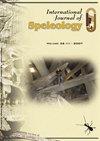伯利兹中部洞穴鳄鱼
IF 1.3
4区 地球科学
Q3 GEOSCIENCES, MULTIDISCIPLINARY
引用次数: 1
摘要
我们提供了伯利兹中部首次系统研究洞穴鳄鱼的结果。近三十年来,Runaway Creek自然保护区的管理人员经常在洞穴中观察鳄鱼的足迹和轨迹,而在地下观察鳄鱼的频率则较低。我们通过涉水(齐腰深)和皮划艇调查了五个以前被确定为鳄鱼栖息地的洞穴;我们还在六个被洪水淹没的洞穴中的五个部署了跟踪摄像头。在两个洞穴中直接观察到了鳄鱼,并拍摄到了一条鳄鱼从第三个洞穴中出来的踪迹。鉴于Morelet’s Crocodile(Crocodylus moreletii(A.H.A.Duméril&Bibron,1851))和American Crocodile?。此外,在之前被确定为鳄鱼栖息地的五个洞穴中,我们通过直接观察和追踪相机确定了至少16种潜在的猎物,包括两种无脊椎动物、四种鱼类、一种海龟、一种鸟类、几种蝙蝠和八种非蝙蝠哺乳动物。强烈建议捕获、检查和冲洗洞穴中的鳄鱼,以及通过踪迹相机持续监测脊椎动物,额外的猎物物种调查,监测洞穴温度,并绘制详细的鳄鱼洞穴地图,以获得描述鳄鱼洞穴使用和优化管理洞穴资源的信息。本文章由计算机程序翻译,如有差异,请以英文原文为准。
Cave-dwelling crocodiles of Central Belize
We provide the results on the first systematic effort to study cave-dwelling crocodiles in central Belize. For nearly three decades, managers at Runaway Creek Nature Reserve have frequently observed crocodile tracks and trackways in caves, while subterranean observations of crocodiles were less frequent. We surveyed five caves previously identified as crocodile habitat by wading (up to waist deep) and kayaking; we also deployed trail cameras in five of six flooded caves. Crocodiles were directly observed in two caves and trail camera footage was captured of a crocodile exiting a third cave. Given that introgression between Morelet’s Crocodile (Crocodylus moreletii (A.H.A. Duméril & Bibron, 1851)) and the American Crocodile (Crocodylus acutus Cuvier, 1807) is high throughout their sympatric range and none of the crocodiles were captured, all individuals were identified as Crocodylus acutus x C. moreletii?. Additionally, in the five caves previously identified as crocodile habitat, we identified at least 16 potential prey species including two invertebrate, four fish, one turtle, one bird, several bat, and eight non-bat mammal species via direct observation and trail cameras. Capture, examination, and stomach flushes of cave-dwelling crocodiles, as well as continued monitoring of vertebrates via trail cameras, additional prey species surveys, monitoring of cave temperatures, and developing detailed cave maps of crocodile caves are highly recommended to obtain the information to both characterize crocodile cave use and optimally manage cave resources.
求助全文
通过发布文献求助,成功后即可免费获取论文全文。
去求助
来源期刊

International Journal of Speleology
地学-地球科学综合
CiteScore
3.10
自引率
23.10%
发文量
12
审稿时长
>12 weeks
期刊介绍:
The International Journal of Speleology has the aim to get cave and karst science known to an increasing number of scientists and scholars. The journal therefore offers the opportunity to all scientists working in and on karst to publish their original research articles or their review papers in an open access, high quality peer reviewed scientific journal at no cost. The journal offers the authors online first, open access, a free PDF of their article, and a wide range of abstracting and indexing services.
 求助内容:
求助内容: 应助结果提醒方式:
应助结果提醒方式:


